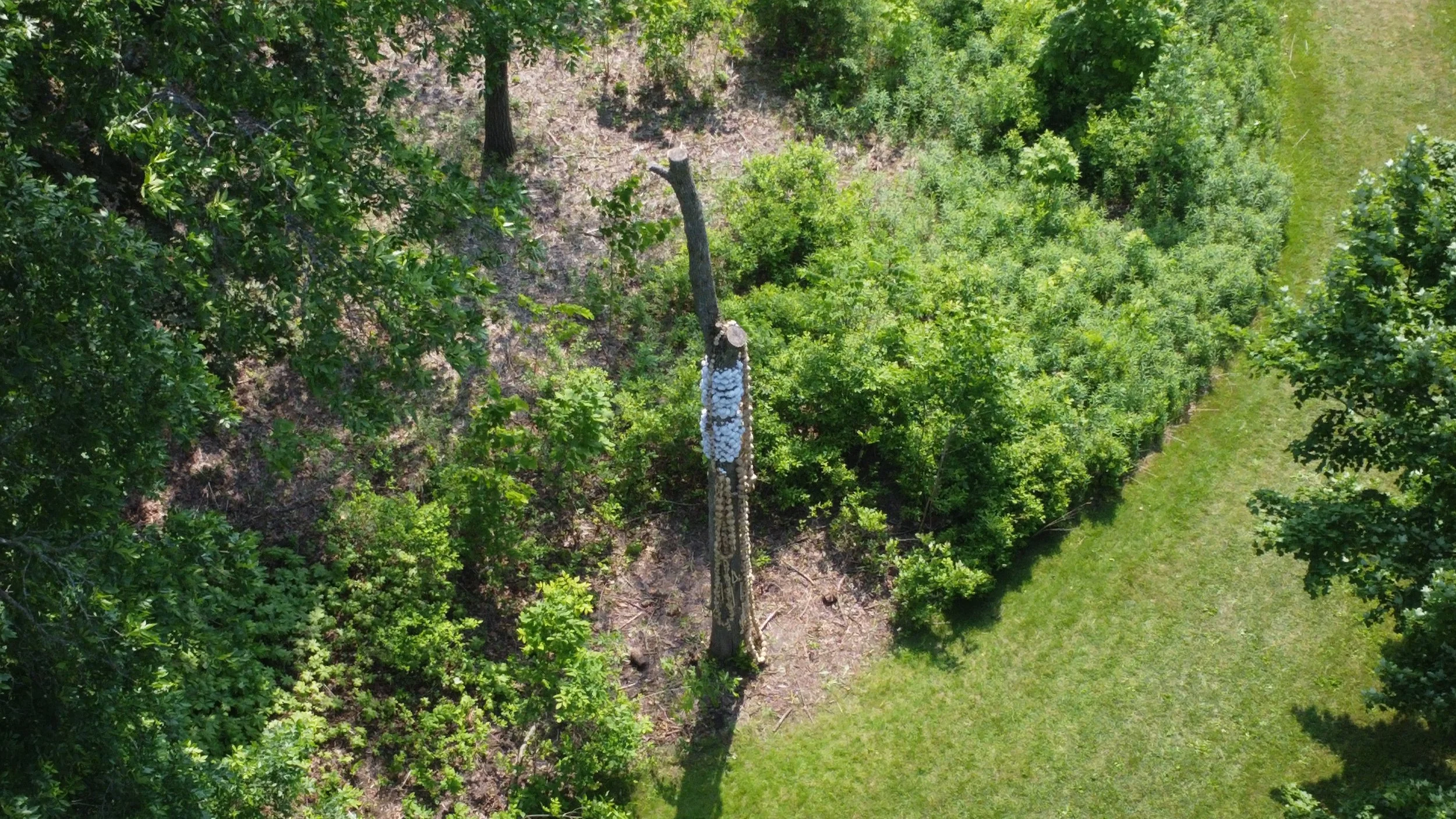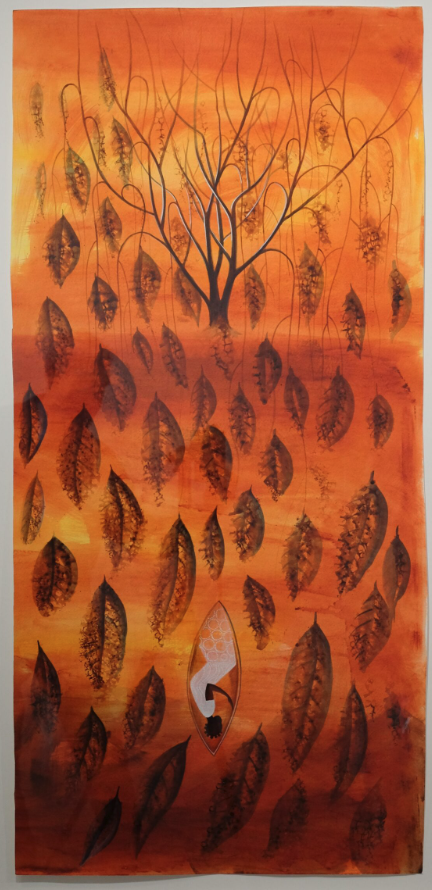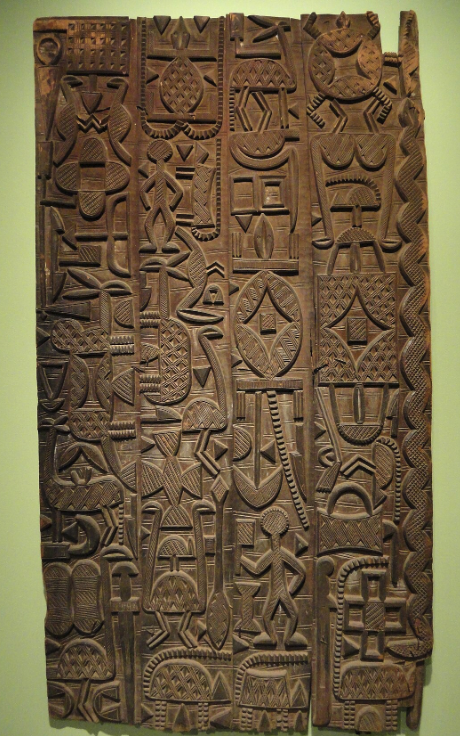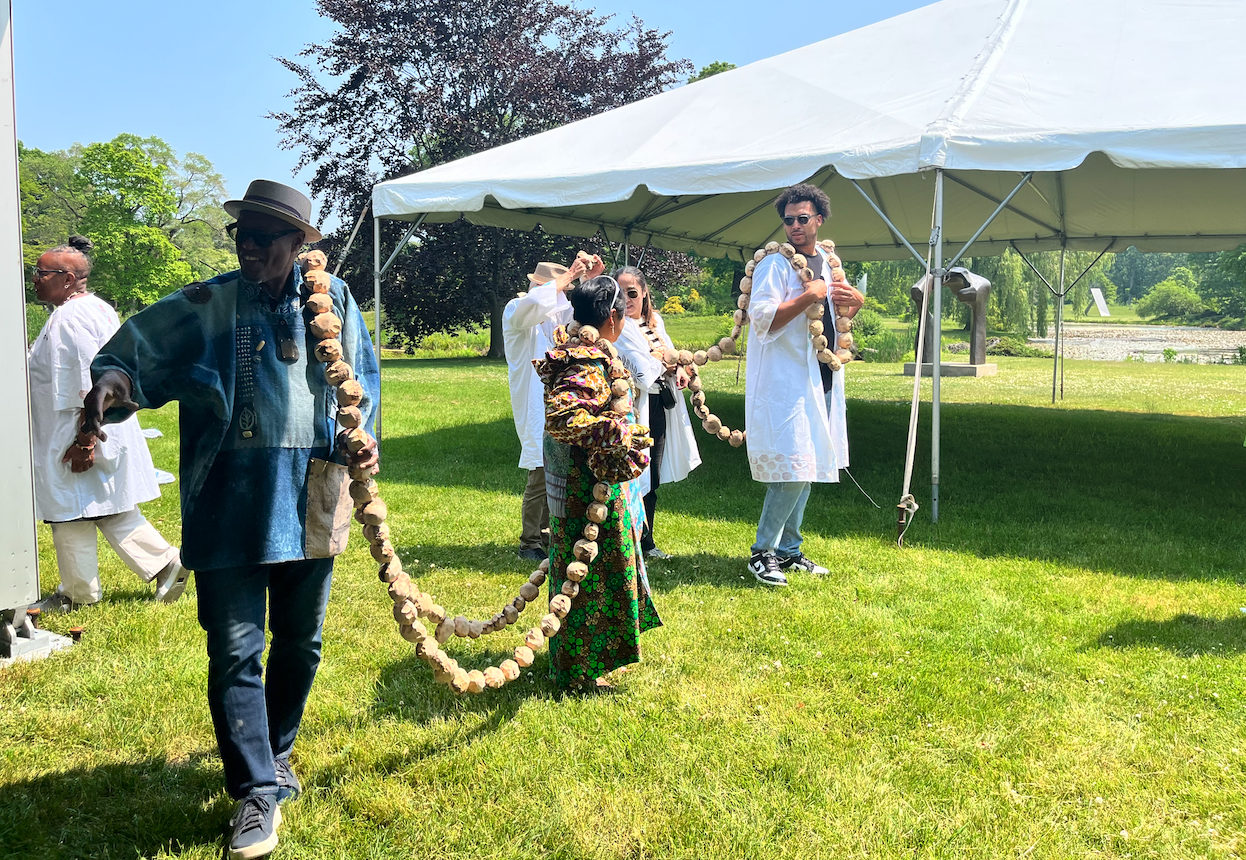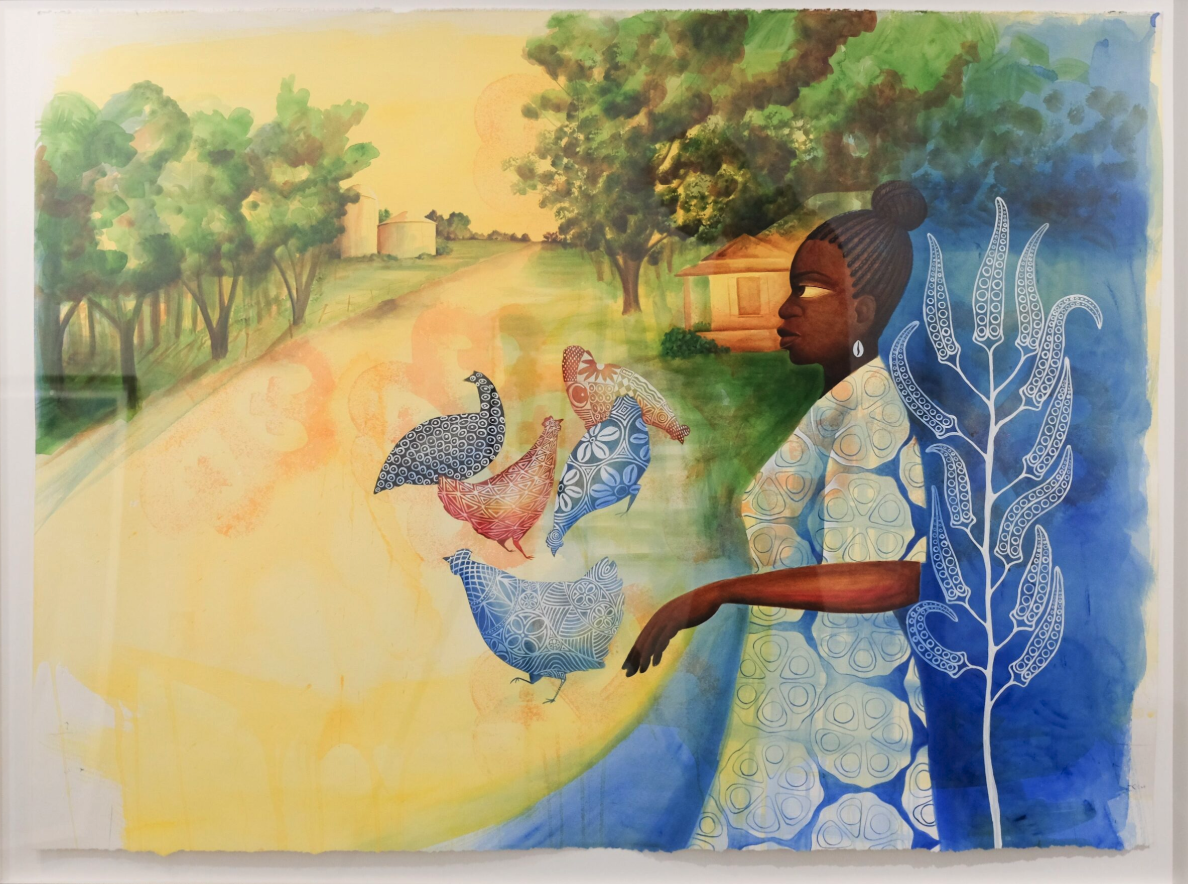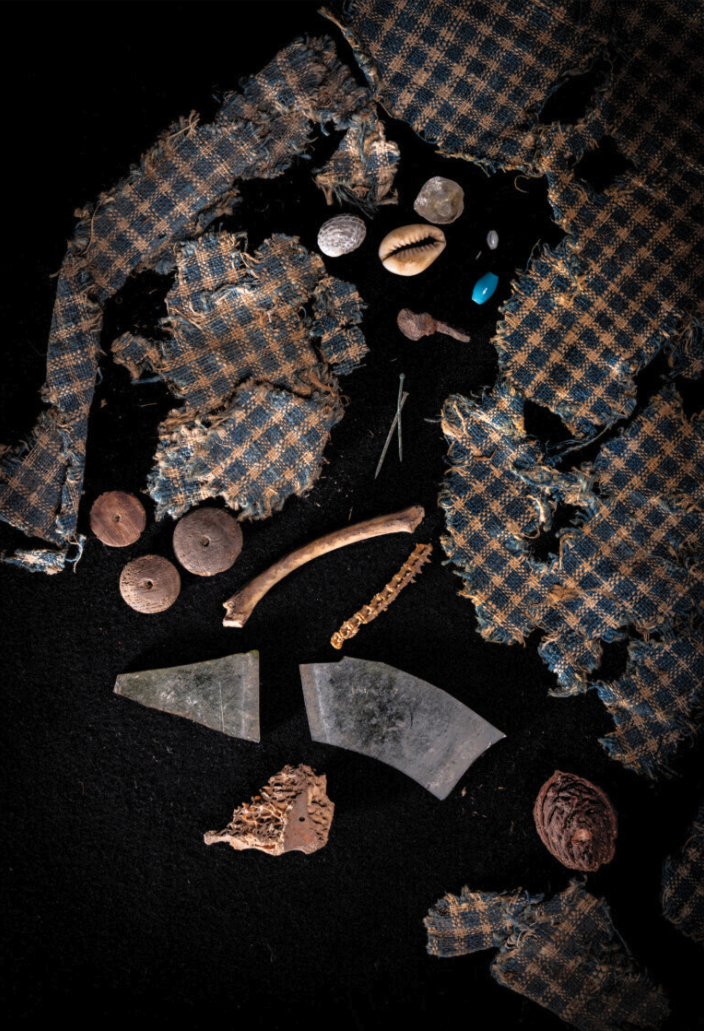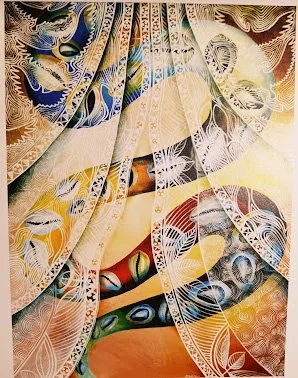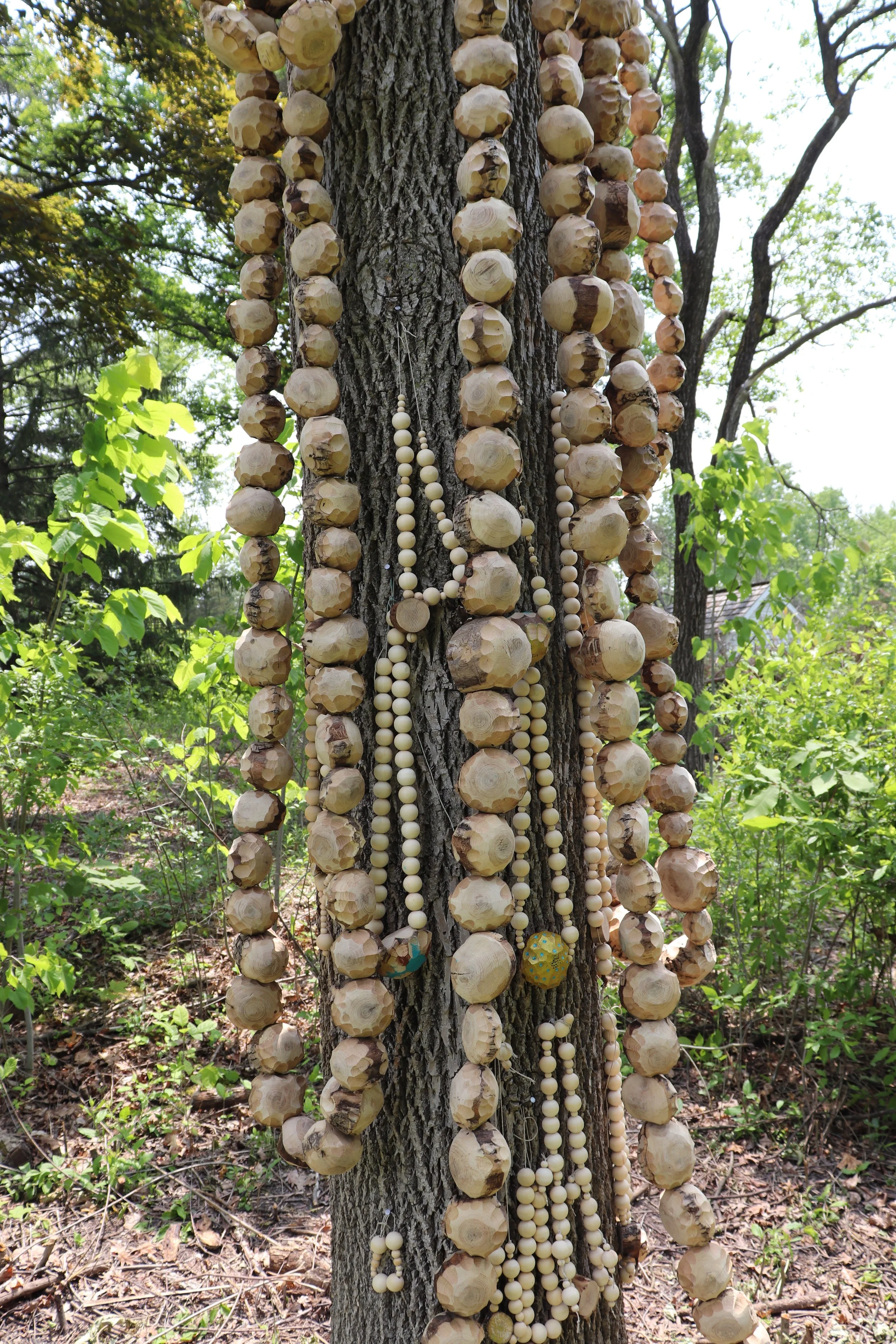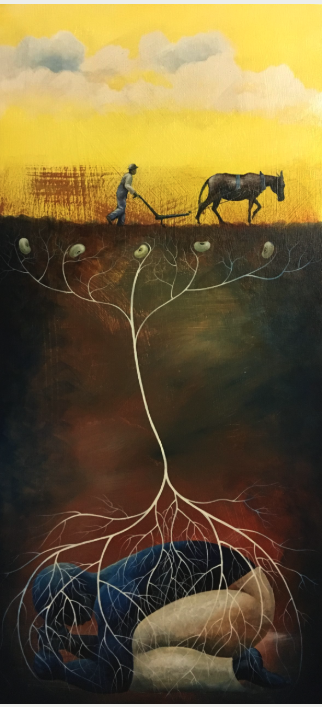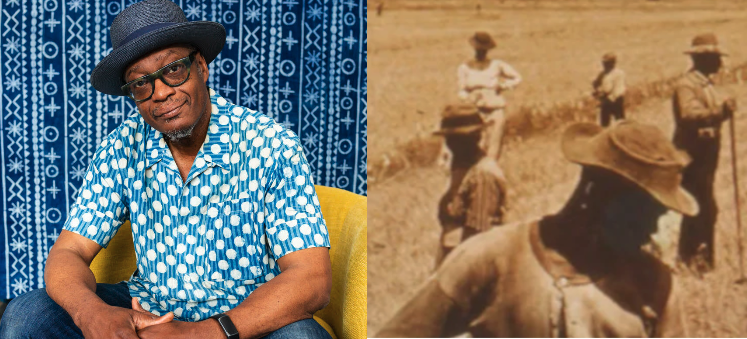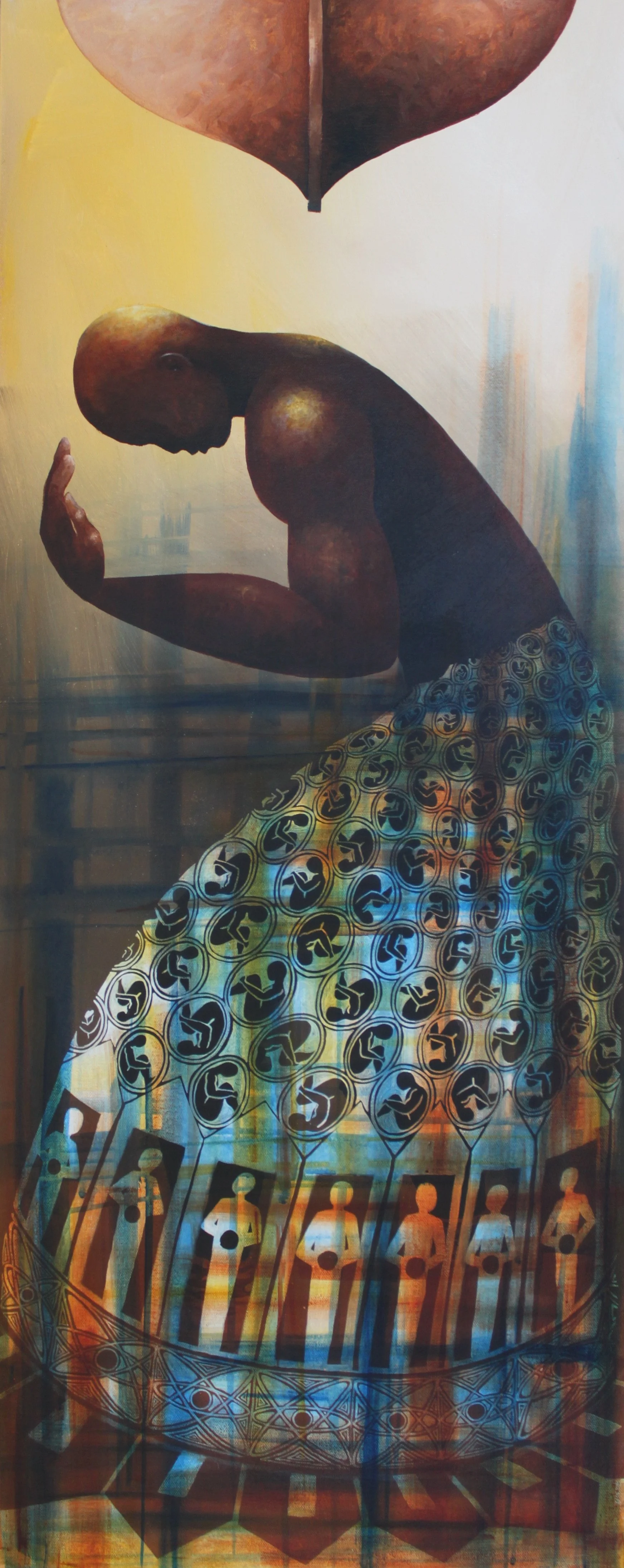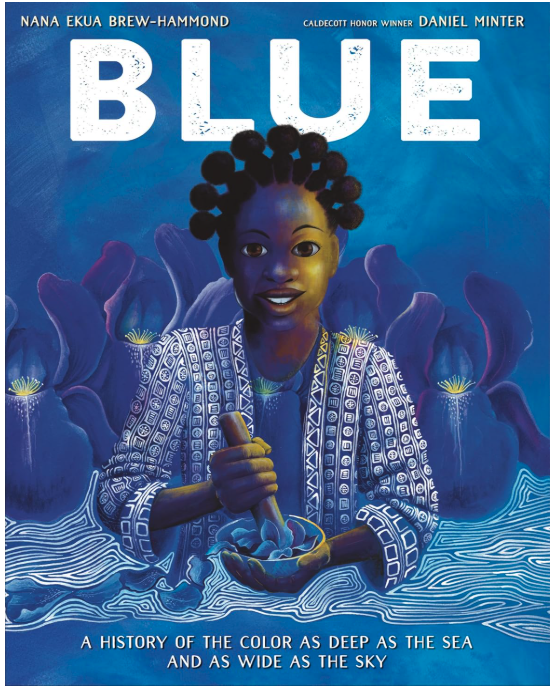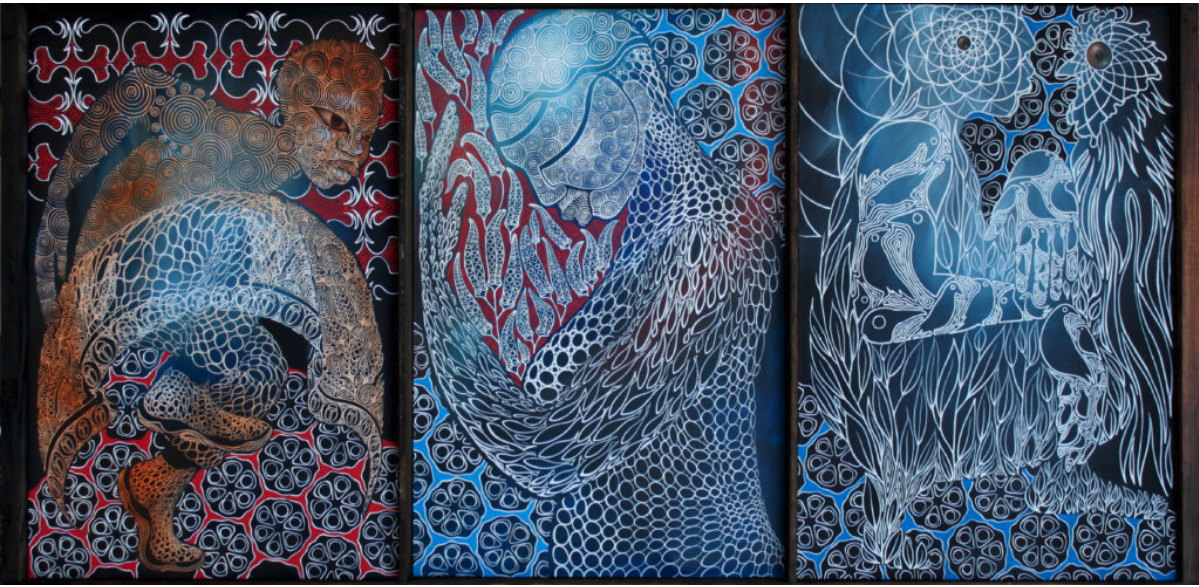A dead ash tree gains new being from its own barren limbs being carved into beads and amid a rich mixture of decaying leaves and insect carapaces, an African diaspora feminine archetype is seeded
Left: Daniel Minter’sHealing Language of Trees installation at the Lynden Sculpture Garden. Right: an illustration from Minter’s 2023 exhibition, A Blue: Daniel Minter and the Layered Narrative of Illustration
Photos: courtesy of the artist.
“If the Earth does not have everything that you need, it will reclaim you and recycle you,” says Daniel Minter.
Recycling and revelation are factors in Minter’s own creative reclamations.
Daniel Minter’s Healing Language of Trees installation at the Lynden Sculpture Garden, Milwaukee, WI.
Daniel Minter leads installation procession at Lynden Sculpture Garden
Daniel Minter, Malaga Girl, Navigaton of Bones, acrylic from the “Othered Displaced from Malaga” series'.
The tear-shaped bundle hanging from the woman’s dress is an nkisi made of gathered bones, representing ancestors buried in the Atlantic. Multiple works from the Malaga series contain minkisi (nkisi plural).
Nkisi is a Bantu word loosely meaning "to take care" and refers to spiritual objects that connect the living world with the spiritual realm.
Below: the nkisi bundle objects were discovered in 2005 beneath the attic floorboards of the historic Wanton-Lyman-Hazard House in Newport, RI. It is believed to have belonged to an enslaved man Cardardo Wanton in the late 18th century.
Photograph courtesy of Mystic Seaport Museum/Joe Michael (permission pending)
(need to get a better photo; this is a 3rd gen photo)
Above: Daniel Minter, A Hidden River, 2011, 18 x 26”, acrylic, oil on wood panel.
Veiled mystery of lacy quarks in a hidden river traversed by an endless serpent
By 2011 when Hidden River (shown above) was painted, Minter was solidifying his lacy veiling style. The hidden aspects are the mystery he generates from iconizing familiar objects.
This painting was created to commemorate the 35th “Art and Survival” anniversary issue of the International Review of African American Art (IRAAA) founded by art historian Samella Lewis and two associates.
The 35 shells in the river commemorate the achievement. “The cowrie also represents clarity of vision spread along the river like the eyes on the back of the endless serpent of Oxumare,” says Minter, in a quote from the foreword in the 35th anniversary issue.
“A three layered veil of light opens to provide a glimpse of the hidden river. while each layer of the veil itself is edged by a pattern of circles that runs its full length,” he explains. “Enclosed by the circles in the veil are three dots representing the three quarks that form the proton.”
For artist and arts administrator Daniel Minter, the creative act is fundamentally one of revelation. As he said during an interview about his Indigo Arts Alliance on the August 12, 2025 edition of the PBS News Hour, he believes it is “the responsibility of an artist to make the unseen seen” in a process that should be carried out with community. This vision, however, extends beyond the human realm and incorporates a world populated by transhuman beings, both spiritual including orixás (orishas) and physical.
This idea of encompassing the seen and the unseen was echoed by nature writer Samaa Abdurraquib, who at a Maine Coastal Botanical Garden interview with Minter three weeks earlier, began by thanking “all of the beings seen and unseen who made it possible for us to gather.”
For Minter, prominent transhuman beings include trees. "Trees move," Minter told me, not just meaning swaying branches. We were discussing his 2023 Healing Language of Trees installation at Milwaukee's Lynden Sculpture Garden, shortly before the debut of his In the Voice of Trees installation at the Coastal Maine Botanical Garden on July 27, 2025.
“Trees can make a lateral movement if there's an area that is closer to the water and they need to get there, he said. “They will send roots towards the water, and those roots will pull them slowly towards that area.” His explanation echoes a parallel phenomenon scientists observe as tree lines (particularly spruce and fir forests) gradually "march" into previously colder regions due to rising global temperatures.
This ability of the tree to adapt and shift its location mirrors Minter's own march across the Americas from his deep grounding in the earth of Ellaville, Georgia and art school in Atlanta to Seattle, Chicago, Salvador (Bahia), and New York City, before finally settling in Portland, Maine.
As he encountered a dead ash tree ravaged by insects, his impulse was to give it symbolic new life for the Lynden commission. The idea was rooted in his rural background. “I was reminded of the people I knew at home carving wood canes and that kind of thing,” he said.
The communal carving memory was his impetus for carving large beads from the limbs of the dead tree to “adorn it with the beads that come out of itself.”
He describes this process as “something before becoming something else again,” adding that “of course a tree is also a powerful symbol on its own.”
Detail of Lyndon Sculpture Garden tree installation.
Carved wood door; circa 1920–1940; Nupe people, Nigeria; Hood Museum of Art.
Photo: Daderot - Own work, https://commons.wikimedia.org/w/index.php?curid=27491365
Wood carving continued among African descendants in the U.S. South to the extent allowable by the circumstances of enslavement and subsequent apartheid. Their common wood-carved items included deep bowls for grinding grains, pipes, canes and chair parts.
Craft and self-sufficient community
Wood carving flourished in colonial African American communities and, to the modern era, was retained to some extent in the rural South.
Around 1753 Benjamin Banneker constructed a clock made almost entirely of wood. Banneker scaled the hand-carved wooden gears and cogs based on his own drawings and calculations. Benjamin's paternal grandfather, Bannka, who was captured in West Africa and had been enslaved, possibly taught his son and/or grandson the fine art of carving.
Further south, wood carving was both utilitarian and a way to unwind.
“There were lots of people just sitting around for a few minutes,” Daniel Minter says, recalling wood carving in his rural home community in a southern part of Georgia. “You take out your pocket knife and you carve. I knew one particular man who was a carpenter who would carve more intricate works, but there was also a lot of relief carving. I feel like it originated with the Africans who came over and it's a southern black tradition—just carving on flat pieces of wood, whether that be decorating it or carving narrative imagery into it.”
Minter says his main focus is not the finished carving or installation itself, but rather the process and practice of creating it and connecting with people along the way. “That tree is a manifestation and representation of the effort and ideas that went into its creation. Without understanding the journey, it's just a tree.”
Opposite: Daniel Minter, Inheritance I, acrylic on wood, 12 x 24.”
Minter prefers wood to canvas for some works.
Inheritance I and 2 are about “the harvest of all that our ancestors have put into this land.” — Daniel Minter
A reflection of Minter’s mother’s guinea fowl are decorated with adire cloth print patterns in this water color that was in the exhibit, A Blue: Daniel Minter and the Layered Narrative of Illustration. Minter combines West African and black Southern elements: indigo textile prints, cowries, okra, cornrows, guinea fowl and faint Adinkra patterns. The A Blue exhibition presented Minter’s illustrations for children’s books.
The lacy gossamer fabric veiling with botanical and marine iconography characterize a number of Daniel Minter paintings as exemplified by Minter’s Removal of Visible Presence for 100 Years (2011), part of his thematic work on the forced removal of a mixed-race community from Malaga Island, Maine, in 1911.
All photographs in this article are courtesy of the artist, unless otherwise noted.
Minter reached out to people in the local Milwaukee community to help carve the beads from chunks of the dead tree. He was capable of carving them all himself and would have finished sooner If he hadn’t put tremendous time and effort into organizing and conducting the carving workshop.
Daniel Minter has a quiet, reflective yet expansive personality that extends from solitary maker absorbed for hours in his large warehouse studio and contemplative loner drawn to forest trails to outgoing organizer who generously uses his energy and other resources to help other artists and communities through the influential Indigo Arts Alliance.
Minter's second tree project, In the Voice of Trees, at the Coastal Maine Botanical Garden, consists of seven cedar trunks stripped of their branches and bound together as a single entity. The trunks symbolize “Sticks in a bundle are unbreakable,” a West African proverb that speaks to the strength of social cohesion and cooperation in community life.
As in Milwaukee, the Maine tree project engaged the community in the creation of beads; however, in Maine, the beads were molded from clay, another earth element, rather than carved from the wood of dead trees.
The tree’s wood “voice” combines with the earthen clay beads in Minter’s In the Voice of Trees intallation.
Inheritance 1
Born in 1961, Daniel Minter’s early life was shaped by a challenging Jim Crow environment and spiritualized by the collective wisdom of his elders. His initial works, depictions of southern black farmers, were a direct reflection of his intent to project the people and environmental orientation of his past into the future.
Minter believes that his remote upbringing was a blessing, athough he didn’t see it that way at the time. “I thought it set me back in a way, tying me to past generations and did not necessarily have anything to offer the future. Yet I was irrevocably connected to it.”
Even after moving to cities, Minter couldn't get away from his formative understanding of the world. “I was not willing to alter myself to something that was not of myself.”
And that understanding made him resistant to the self-centered aspirations and monetary motives of the establishment art world. “I know that the work I do benefits me practically and I know that the people where I'm from can read it and understand it and it does something for them as well.”
The Jim Crow system had made his people resilient. “That system we were forced to live under strengthened us in a lot of ways,” he reflects. The children and adolescents did well in school. “It gave us an appreciation for education because the education was coming from people you knew, people you trusted. It truly gave you the sense of who you could rely on.”
Close to the land, weeding by hand
He describes a childhood where the entire sustenance of the community came directly from the earth. “You grew a lot of your own food. My father had fields that were in different places and I worked on those. I also worked in the fields of other black farmers to help get their crops in. Picked peas, hoed leaves out of cotton and corn fields. And most of the weeding was done by hand.”
Weeding by hand! No herbicides. True agroecology before it acquired that fancy name.
This intimate connection with the land also shaped Minter’s understanding of the economy of resourcefulness. “There wouldn't be any surplus because if somebody had a bunch of corn, come harvest time, more than they needed, they would give a bushel of it to neighbors.” Their diet, consisting largely of fresh, seasonal produce, was exceptionally fresh and nutritious compared to the national “supermarket” chains that arose after WW 11 with large stocks of canned and packaged foods, wilting iceberg lettuce and small, juiceless tomatoes.
“We always had a big food garden. Almost everybody in the town had a plot in their yard where they grew lots of cucumbers or watermelons. And other people might grow lots of eggplants and tomatoes. The foods of the summer were different from the foods of the winter. In the summer, we had fresh cobblers, black-eyed peas, and butter beans—everything was fresh. And in the winter you'd have dried peas, and if you made a cobbler, it was gonna be from canned peaches. And folks had a yard hog that was slaughtered in the wintertime.”
“What about a cauldron?” I asked, imagining the big pots used to boil pigs to remove the hairs. Minter was remembering another use of the big black kettle in the yard: “That's what my momma washed clothes in.” His mother had 12 children. Super woman! Minter associates his mother with Yemoja, who in Yoruba philosophy, is associated with motherhood, the sea, rivers and the moon..
As late as the 1960s, black rural women were still using this incredibly strenuous way to wash clothes, a detail that brings to mind John Biggers’s reverence for these women, as depicted with washboard, kettle and wringing cloth iconography in this lithograph and similar symbols in his other depictions of southern black women.
The tripod is more distinct in this painting along with other signature elements. (Insert image details)
Insert caption details for this painting.
In addition to the camera on tripod, the calipher is a mech tech motif in some of Minter’s paintings. Most famously, the calipher was used by anthropologist Franz Boas to disprove racial ideas about only genealogy shaping skull formations; environmental factors also were an influence.
The boat element is also prevalent in Minter’s imagery.
The ship shown above is an icon representing the transAtlantic slave trade. That symbolism explicitly appears in this rendering by Minter.
Anthropologist Rachel Harding’s eloquence in describing Daniel Minter’s work becomes poetry.
Gathered here are the exiled silhouettes of Malaga Island, Maine; the wide-eyed/squint-eyed faces of Ellaville; the iawos and orixás of Candomblé; and the ordinary tools of an older, yet present, Southern Blackness – kitchen combs, nails, sideways glances, stacy adams by the barbed-wire fence, big bones and farming tools, rocking chairs and the bare black arms of trees.
— Rachel Harding referring to Daniel Minter’s Hammonds House retrospective exhibit on 2001.
Daniel Minter, A Distant Holla, Currency Exchange (will insert remaining details)
Insert caption details here.
Daniel Minter and detail from old stereoscope slide of southern black farmers. Like them, Minter is seldom without his hat, an icon of southern agrarian life.
Article under construction
Daniel Minter is the last generation to come out of the full traditional black southern culture that includes wood carving. When he was growing up in the 1960s, “it was more like the 1940s or ‘30s” there, he says. Now Minter is an energetic culture-carrier and preservationist of old traditions.
“Even simple actions, like sweeping our front yards with a brush broom – something I thought was just a common chore growing up – are very connected to the (African) continent.
My mother's passion for Guinea fowl, too. I've grown to see the connections there. My mother preferred guinea fowl over chickens because of their habits, their appearance, and the sounds they made. I later learned that the guinea fowl was also the food for Yemoja. I strongly relate those ideas of mothering, which I feel my mother exemplified, to the orixá Yemoja.”
Because of the spirituality and the close knit community of Minter’s youth and despite the hardship, the remoteness of Ellaville was a blessing.
Citing a painting from his black agrarian works (Inheritance 1) shown above), Minter says, “It’s about the harvest of all that our ancestors have put into this land.”
Minter’s style of painting evolved to incorporate a gossamer element: white outlines of botanical, aquatic, and animal motifs—for example, lacy filigree leaves, vines, and frogs. “I don't really have a name for it—sometimes I'll call it a veil,” says Minter. “I started doing that out of two reasons: conversations with John Biggers and also spending time in Salvador, Bahia.”
“John Biggers was probably the most affirming thing in my artwork and in my life as an artist,” he says. “I saw what he was doing—thinking about, talking about and creating in his work. He was communicating with the same basic community that I was trying to communicate with.” Minter adds that Biggers showed him that “it's possible to communicate with a small community in South Georgia and at the same time communicate with one that's in Ghana or Harlem.”
The gossamer veil is a layer that indicates “the presence, or the embodiment of spirit, and the ability to exist in that realm and this one at the same time,” Minter explains and credits his conversations with both John Biggers and Leo Tanguma, a Mexican American muralist, with helping him understand this concept. “The three of us were trying to incorporate the spiritual realm but using figures that were the kind of people we all three grew up with—rural people who were connected to the land but in a way that, even if they were in servitude, they would find a way for the land to serve them as well.”
Being attuned to nature in a very deep way
The veiling⇆revealing technique also relates to his use of the color black. “One of the primary reasons is the determination to be present as myself,” Minter says. He works with the “full spectrum of that blackness—from the deepest blacks of deep space to the deepest blues of the bottom of the ocean.” By doing so, he encourages viewers to look beyond the surface and interpret the other things within the work. “The voice speaking, it is a black voice,” he says, “and it's one that resonates with the universe.”
While Daniel Minter finds personal and universal resonance in the "full spectrum of blackness," his connection to these concepts was formalized during his time in Bahia, Brazil, where he was introduced to Candomblé, the Yoruba-based spiritual system of the orishas.
“It's about working out understanding based on numbers and patterns,” he says. “It helps me to recognize the unseen influences on what's in front of me—whether those influences are beside it, below it, or above it. The more of these connections you see, the clearer your understanding becomes. These relations aren't always visible, but we constantly encounter unseen influences. For example, the traffic you don't see influences your progress when driving to work. These invisible influences are powerful ways of helping us understand the whole paradigm.”
Minter was influenced by such spirits growing up in Georgia:
“But I did not have a name for them. I felt connected to the spirits and the force of the field but I did not have a name for them until I got to Salvador (in Bahia, Brazil).” He learned about them first through conversations with artists who would give him a name for the spirit connected to a piece of art. “That’s where I became familiar with Candomblé and the amount of organization of those ideas around the spirit that exists within the living world.”
“How did you sense those spirits when you were in Georgia?”
“By the way I was drawn to, and am still drawn to, any grouping of trees or forest,” Minter replies. “I want to go there and I always feel a sense of presence. It’s a place where it's easy for me to connect to being a part of existence and not a part of someone else's 'mechanism'.”
When Europeans discovered that enslaved Africans believed in orishas, they “thought that that was a part of being the devil,” Minter explains. “But actually it's a way of being attuned to nature in a very deep way. And needing a way to express it in a metaphorical way that’s also very real in terms of what it represents.”
Another major environmental element in Minter's life and work is the indigo plant. His journey with indigo began long before he consciously embraced it, steeped in the very soil of his regional, South Carolina-Georgia homeland where indigo was cultivated before the advent of commercial dyes. Many enslaved Africans brought with them extensive knowledge and expertise in indigo cultivation and processing from their homelands. Some were so valued for their skills that they were called "indigo slaves."
When Daniel and Marcia Minter co-founded and named the Indigo Arts Alliance (IAA), they chose the botanical name for its beauty, historical significance, and its ability to represent a heritage shared by Africans and southern African Americans.
The indigo plant is also represented by Minter’s illustrations for Blue: A History of the Color as Deep as the Sea and as Wide as the Sky, a young readers’ book by Nana Ekua Brew-Hammond.
Reflecting on motivation to found IAA, Minter says “I realized that the work artists do requires other artists — those with similar sensibilities, aesthetics, or a similar care for their community — to serve it in some way and having a place to create and talk about the work.”
If the Earth does not have everything that you need, it will reclaim you and recycle you
After Minter left Georgia, he lived and worked in Seattle where he met and married a graphic designer. Marcia and Daniel moved to New York City. Then, finally they settled in New England by the water – the archipelago of Portland that has lots of inlets.
I wondered whether after moving to Portland, the water themes became more prominent and the environmental themes expanded in Minter’s multi-media works.
“I think that they are probably more prominent for two reasons,” Minter says. “I'm really interested in connecting the real life I have to the rural life that I had in Georgia. In both, I nourish myself from the earth. The communities are vastly different, but the earth is the same. Wherever you go, the earth has everything you need. If it does not have everything that you need, it will reclaim you and recycle you.”
The move to Portland and his deeper understanding of the Orisha Yemọja, the mother of the water and ocean, have also influenced his work. “It also helped me understand something about myself: I am not comfortable in water. I don't swim, and I've never liked swimming,” he says, true to his upbringing in a rural, low per capita income, landlocked area.
He then recounts a dream in which he and Marcia, whose orisha is Yemọja, helped him fly over water. “I feel like it just gave me an understanding that I needed Yemọja's permission before crossing the ocean.”
Minter also notes that his orisha is Ogun and later returns to the topic: Ogun. “He is one of the spirits of the forest, specifically the spirit of opening paths through the forest, creating new routes, and of farming fields. He's also associated with tools, particularly metal tools like wood-cutting tools, and the general development of material, primarily iron. These energies were incorporated into the energies of the Orisha Ogun for the benefit of civilization, for us as people.
Knowing this gives clarity to many of the reasons behind the ways that I think—the way that I do. Not that it gives them justification, but it does provide a little clarity. It's knowing that there is a system of thinking that's thousands of years old, which has been contemplating how we live in the world and how our different personalities and energies can be used to make a whole community in this world.”
Marine scenes and aquatic motifs— symbolic boat imagery, Malaga Island figures evoking Yoruban figures who govern waters, and cowries and other shells—constitute an African-influenced, marine sensibility in his work. Maine’s Malaga Island was once home to a mixed-race community, including many African Americans, from the mid-1800s until they were forcibly removed in 1912.
Minter is currently working on a book that features his work in dialogue with the work of historian/anthropologist Rachel Elizabeth Harding. At one point during their long, cross-fertilizing collaboration and friendship, Harding wrote that Minter is concerned about “the commodification of Black bodies and Black productivity at the founding of the modern world – and how slavery, and the persistence of Black fungibility has provided the reigning paradigm for capitalism into the 21st century; using up everything and everybody until there is nothing left. And then using the carcass.”
Harding added that Minter’s magical operandi reveal “those vital, transformative modes of being, that are cultivated over generations and that carry an-other meaning of the possible (an afrofuturist vision) at their heart. Minter’s art is the labor of tender excavation, unearthing the wisdom buried in the culture – sometimes deep in the terrain of memory, sometimes flat-footed in plain sight all around us.” ( Quote from “Quantum Exchange: The Diasporic Art of Daniel Minter” by Rachel Harding in Rethinking Marxism, 33:1, pp. 30-51 (2021).
The Minter-Harding co-authored book will, he says, “encompass all the themes we've highlighted in our collaborative journey over the years. It involves discussing the work, her writings, and pairing pieces together to create a walk-through of our collaboration.”
Another project involves illustrating themes they have discussed. “I've realized that within my work, there are consistent elements: the human body or figure, which I often use as a metaphor; the representation of spirit through color and line; and the use of metaphor,” says Minter.
When I pointed out the repetition of the word “metaphor,” Minter clarified: “I think of the ways in which we expand on the metaphor outside of the piece of work that generates it. How one metaphor can lead to another. Similar to the way the removal of the black and mixed-race families on Malaga Island here is a macrocosm of the removal and destruction of black communities all over the South during that same period. The metaphor can expand to talk about what was going on in the whole country at that time.”
Blue: A History of the Color as Deep as the Sea and Wide as the Sky young readers book by Ekua Brew Hammond; illustrated by Daniel Minter
Daniel Minter provided the cover art for Rachel Minter’s A Refuge in Thunder book based on her PhD research on how Bahian Candomble practices were a lifeline and shield against psychological and cultural extinction.
We noticed how the Hidden River painting relates to the Xango and Ogun painting by Abdias do Nascimento (shown above right). The connection was made because the 35th IRAAA anniversary issue coincided with Hampton University's fall 2011 fundraising program to support the treatment of patients needing financial aid for a medical technology offered by Hampton University Proton Therapy Center.
In his Hidden River painting, Minter evokes the spirit of Ogun, orisha of metalworking and technology, to symbolize the university's sci-tech's capacity, along with the endless river serpent, Oxumare. This evocation echoes how Dianne Reeves powerfully invokes the energies of southern African American orixás (“old souls”) on this video as she sings the song from which the following lyrics are excerpted.
“…Consecrated earth it was a sacred place
A perfect balance of nature a gift to all the world
Still I throw away the oyster just to wear the pearl
In my darkest deep depression
They give counsel to my soul
They open up new meaning
And God's power takes control....
Songwriters: Dianne Reeves / Eduardo Del Barrio
Abdias do Nascimento, Xango and Ogun (grantors of technology), arcylic, no date (before 1977).
“Sticks in a bundle are unbreakable” proverb
The West African proverb is represented by seven tree trunks bound as one in Daniel Minter’s In the Voice of Trees at the Coastal Maine Botanical Garden, a 2025 installation.
Minter’s work is a unified expression of his core background and beliefs. This is a “universe of freedom-making” that, as Minter says, “lives within us, within our DNA. Even in challenging situations, we can still cultivate our freedom. Even if our bodies are chained, we have the capacity to cultivate freedom within ourselves, and we seize an opportunity to do that every time we're able to connect with our source material, which is the earth.”
The “universe of freedom-making” specifically refers to the title of Minter’s current exhibition. Presented by the National Museum of African American History & Culture in DC, a Universe of Freedom Making is one part of the two-part international exhibition In Slavery’s Wake: Making Black Freedom in the World which opened at NAAAHC in December 2024 and travels to the Museu Histórico Nacional, Rio de Janeiro, Brazil for exhibition between November 2025 and March 2026.
“... gathering momentum in the same direction of freedom”
This spiritual wellspring is an indigenous way of comprehending the world that, as Minter says, “is also about a black and indigenous attitude of generosity and welcome.”
The traditions—West African, Bahian, indigenous North American—are distinctive but also very complementary. Both can happen at the same time: difference and union. On the black and brown tip, Minter begins by recalling his childhood.
When I grew up, we did not have strong connections to the indigenous community, though one of my aunts was indigenous. My uncle had married a woman from, I think, North Carolina. She was indigenous, and we used to love talking to her because her name was so long. We tried to remember her whole name but we just called her Aunt Ken.
I say that to say there has always been an underlying relationship but it's been difficult because we were striving for assimilation and they were also striving for assimilation. We were resisting slavery and subjugation and they were resisting colonization. Those forces were acting on our relationships with each other, so it's been fraught. However, when those external forces were put aside, there was generally a connection.
I didn't truly experience this until the welcome table event in Denver with Rachel Harding and the Veterans of Hope. They held a community symposium and a gathering of black and indigenous communities, which was a wonderful event where black, indigenous, Latino, and white communities talked and gathered momentum in the same direction of freedom.
When I moved to Maine, I learned that there's a large Indigenous community here, but there was very little visibility of them, much less than out West. I felt they were a strong community and wanted to do more with them. So, I've really wanted to include black and indigenous ideas and aesthetics within Indigo's mission and ideology. We host indigenous artists from this area.
Until being here, during a welcoming ceremony performed by an indigenous artist, I had never truly felt welcomed to walk on this land. They have a welcoming song they sing; they call themselves the People of the Dawn—the people who the light hits first when it comes over the water. This is beautiful because the land here jets out into the ocean and gets daylight first. And when people come down the river or on the ocean, they welcome them with that song. We've had that song sung for us a few times, and I must say, it was the first time I felt welcome.”
Going against what inherently wants to be
Towards the end of a wide-ranging exchange about cultural and environmental ecologies, we agree that it's MAGA’s loss not to understand that unity-in-diversity and inclusivity are humanity’s wealth, the real wealth.
Minter says that the people at the top are acting in such an authoritarian way because they do not understand this concept of wealth: “This is all about control and they will continue to lose control because they're going against what inherently wants to be.”
Getting into the time space of trees
Minter’s beliefs and experiences are reflected in the collaboration between Indigo Arts Alliance based in Portland and the Coastal Maine Botanical Gardens in Boothbay, Maine.
The two organizations developed a three-year partnership to convene the Deconstructing the Boundaries symposia to bring together “community members of all backgrounds to ground ourselves in difficult conversations, creative expression and the power of being together.”
Loss of the integral West African wood carving tradition
During our conversation, I moan about southern black people losing the wood carving tradition.
“We don't have the time … and the joy,” Minter replies. “We’re disconnecting ourselves from our understanding of the physical world by turning to the digital world. That's a form of control, when we’re not responding to our own natural surroundings but when we’re controlled by the media, and the media is controlled by corporations. They want our energy and our labor to run their machines.”

